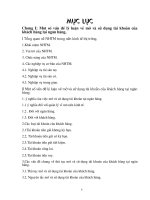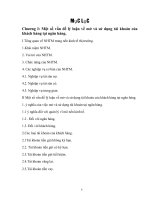Lạm dụng các loại ma túy mới: ý nghĩa lâm sàng
Bạn đang xem bản rút gọn của tài liệu. Xem và tải ngay bản đầy đủ của tài liệu tại đây (2.82 MB, 38 trang )
<span class='text_page_counter'>(1)</span><div class='page_container' data-page=1>
<b>Emerging Drugs of Abuse: </b>
<b>Clinical Implications </b>
<b>Scott Phillips, MD, FACP, FACMT, FAACT</b>
<b>Associate Medical Director</b>
</div>
<span class='text_page_counter'>(2)</span><div class='page_container' data-page=2>
“Synthetic” Drugs
Drugs like Molly, MDMA, 2C-E, bath salts, tend
to be a small segment of drug use
Present a problem because they rapidly change
</div>
<span class='text_page_counter'>(3)</span><div class='page_container' data-page=3>
History
1990s: surge in use of
3,4-methylenedioxy-N-methylamphetamine (MDMA), rave drugs
Many new derivatives available now
Most contain little MDMA
Amphetamine, DXM, BZP, etc.
Next generation includes:
Tryptamines
Phenylethylamines
</div>
<span class='text_page_counter'>(4)</span><div class='page_container' data-page=4>
Tryptamines
Re-emerged on drug scene
Include DMT, 5-MeO-DIPT, 5-MeO-DMT,
and more
Yakee plant, Foxy methoxy, alpha-O, O-DMS,
alpha and bufo toad secretions
Similar to psilocybin, psilocin, and bufotenine
Derivatives of tryptamine contain stimulant
</div>
<span class='text_page_counter'>(5)</span><div class='page_container' data-page=5></div>
<span class='text_page_counter'>(6)</span><div class='page_container' data-page=6>
Tryptamine Pharmacology
Mechanism of action not fully elucidated
Similar to classical hallucinogens like LSD
Direct agonists at 5-HT<sub>2A</sub> and 5-HT<sub>1C</sub>
Presentation includes
Empathy
Euphoria
Visual/auditory hallucinations
Tachycardia/HTN
Confusion
Seizures
</div>
<span class='text_page_counter'>(7)</span><div class='page_container' data-page=7>
Dimethyltryptamine (DMT)
DMT discovered in
1960s
“Businessman’s
lunch”
DMT used in South
America for spiritual
and medicinal
purposes
Available in various
</div>
<span class='text_page_counter'>(8)</span><div class='page_container' data-page=8>
Management of Tryptamine Toxicity
Treatment
Supportive care
No antidotes
Nice, quiet dark room
</div>
<span class='text_page_counter'>(9)</span><div class='page_container' data-page=9></div>
<span class='text_page_counter'>(10)</span><div class='page_container' data-page=10>
Phenylethylamines
Newer designer analogues designated “2C”
series
DOM: STP (Serenity, Tranquility, & Peace)
Mescaline: Mesc, Buttons, Cactus
2C-B: Nexus, Bromo, Bees, Venus
2C-T-2: Triptasy or Beautiful
2C-E: Europa, Eternity
2C-T-7: Blue Mystic and 7th Heaven
</div>
<span class='text_page_counter'>(11)</span><div class='page_container' data-page=11>
Phenylethylamines
Pharmacology similar to bath salts
Affect dopamine, norepinephrine and serotonin
Increase release of catecholamines and inhibit the
reuptake of them
Ring substitutions increase affinity for 5-HT<sub>2</sub>
receptors
Agonist properties at other 5-HT substypes
and α<sub>1</sub>-adrenergic receptor
</div>
<span class='text_page_counter'>(12)</span><div class='page_container' data-page=12></div>
<span class='text_page_counter'>(13)</span><div class='page_container' data-page=13>
Phenylethylamines
Hallucinations
Visual and auditory
Euphoria
Entactogen
Tachycardia
Paranoia
Delirium
Bruxism
Violent behavior
Refractory seizures
and serotonin toxicity
with 2C-I reported
Recently in Seattle
Death in 15 yo by
25i-NBOMe
Fatal cardiac arrest
after 2C-E
No literature on
</div>
<span class='text_page_counter'>(14)</span><div class='page_container' data-page=14>
Molly
Highly purified form of MDMA
Methylene-dioxy-methamphetamine
Oftentimes contains very little MDMA
Other drugs sold as Molly
MDMA is neurotoxic even with a single dose
Destroys 5-HT receptors and serotonergic neurons
Long terms effects result in neuroendocrine
impairments to deficits in verbal memory and
reasoning
Chronic psychosis responds poorly to traditional
therapy
</div>
<span class='text_page_counter'>(15)</span><div class='page_container' data-page=15>
Management
In the ED
Management largely supportive
Benzodiazepines as indicated for sympathomimetic
symptoms
Hyperthermia is what kills these patients
Body temps of 111 degrees F
Rapid cooling with ice and chilled saline fluids
</div>
<span class='text_page_counter'>(16)</span><div class='page_container' data-page=16></div>
<span class='text_page_counter'>(17)</span><div class='page_container' data-page=17>
“NMUO”
</div>
<span class='text_page_counter'>(18)</span><div class='page_container' data-page=18></div>
<span class='text_page_counter'>(19)</span><div class='page_container' data-page=19>
Opiate Prescribing
Steady increase in opioid prescribing from 2006,
Total # of Rx’s peaked in 2012 at >255 million and a rate of 81.3 Rx per 100
The overall national opioid prescribing rate declined from 2012 to
2016
In 2016, the Rx rate had fallen to the lowest in 10 years at 66.5 Rx per 100
over 214 million total opioid prescriptions).
However, in 2016, prescribing rates continue to remain very high in
areas across the country.
In ¼ of U.S. counties, opioid Rx’s were dispensed for every
person.
Opioid prescribing rate in 2016 was 66.5 prescriptions per 100
</div>
<span class='text_page_counter'>(20)</span><div class='page_container' data-page=20>
Fentanyl
50-100 times > potent than Morphine
50 times > than heroin
1 kg can make 1 million tablets
20-80 USD per tablet
</div>
<span class='text_page_counter'>(21)</span><div class='page_container' data-page=21>
Methamphetamine History
Developed in late 1800s and used during
WWII to keep troops awake
Given to pilots to enhance “performance”
Used previously as diet aid, antidepressant,
stimulant, and drug of abuse
Street names
Speed, Krystal meth, Tina, Ice, Crank,
</div>
<span class='text_page_counter'>(22)</span><div class='page_container' data-page=22>
Management
</div>
<span class='text_page_counter'>(23)</span><div class='page_container' data-page=23></div>
<span class='text_page_counter'>(24)</span><div class='page_container' data-page=24>
Where did it come from?
1960s: research into THC-like compounds
Analgesic and anti-inflammatory minus
psychotropic effects
Recognized as drugs of abuse in early 2000’s
in Europe
Dr. JW Huffman researched THC analogues
for use in cancer and AIDS patients
Developer of JWH compounds
</div>
<span class='text_page_counter'>(25)</span><div class='page_container' data-page=25>
What are they?
Synthetic cannabinoids which work on the
CB1 and CB2 receptor like THC
Marketed as herbal incense, herbal smoking
blends, potpourri, etc.
Spice, K2, Mr. Nice Guy, Legal Funk, Tai Fun
Misleading packaging
Not for human consumption
Commonly smoked
New chemicals like PINACA and
</div>
<span class='text_page_counter'>(26)</span><div class='page_container' data-page=26>
Pharmacology
Effects likely from mixture of herbs and actual
synthetic compounds
Baybean, Beach bean, Dwarf skullcap, red clover,
vanilla, honey, wild dagga and more
Affects CB1 and CB2 receptors found in
CNS/PNS
Responsible for elevating mood, anxiety, cognition
Responsible for reducing inflammation induced pain
</div>
<span class='text_page_counter'>(27)</span><div class='page_container' data-page=27>
Clinical Manifestation
Most information from case reports and case
series
Psychiatric effects predominate
Anxiety, paranoia, agitation, delusions, and
psychosis
Physical manifestations
Tachycardia, HTN, diaphoresis, seizures, muscle
</div>
<span class='text_page_counter'>(28)</span><div class='page_container' data-page=28>
Management
Agitated Delirium
Like bath salts, unpredictable
ABCs
GI decontamination
No antidote
Supportive care
</div>
<span class='text_page_counter'>(29)</span><div class='page_container' data-page=29></div>
<span class='text_page_counter'>(30)</span><div class='page_container' data-page=30>
What are bath salts?
Synthetic cathinone derivatives
Synthesized as early as 1928 and studied for
medical use
Methcathinone (1928)
Mephedrone (1929)
Used as antidepressant in 1930s in Soviet
Union
Bupropion only cathinone with medical
</div>
<span class='text_page_counter'>(31)</span><div class='page_container' data-page=31>
Common Synthetic Cathinones and
Names
</div>
<span class='text_page_counter'>(32)</span><div class='page_container' data-page=32>
α-
<b>PVP</b>
α-Pyrrolidinopentiophenone (also known as
α-pyrrolidinovalerophenone, α-PVP, O-2387,
β-keto-prolintane, prolintanone, or
desmethylpyrovalerone) “Flakka”
Substituted cathinone & pyrrolidine
Developed in the 1960s
Heightened tactile enhancement
Norepinephrine-dopamine reuptake inhibitor
</div>
<span class='text_page_counter'>(33)</span><div class='page_container' data-page=33>
Pharmacology
β-ketonated amphetamines
Ketone on β carbon leads to decreased CNS
penetration increased doses increased
effects
</div>
<span class='text_page_counter'>(34)</span><div class='page_container' data-page=34>
Clinical Manifestations
Agitation (53.3%)
Tachycardia (40%)
Hypertension (20%)
Seizures (20%)
Palpitations (13.3%)
Hallucinations/delusions
Paranoia
Renal failure
</div>
<span class='text_page_counter'>(35)</span><div class='page_container' data-page=35>
Management
Protect yourself!
Difficult to manage patients and unpredictable
behavior
ABCs
No antidote
GI decontamination
Benzodiazepines, barbiturates for agitation,
hallucinations and seizures
Caution against using haloperidol
</div>
<span class='text_page_counter'>(36)</span><div class='page_container' data-page=36>
Loperamide & Diphenoxylate Abuse
Inexpensive OTC anti-diarrheal with peripheral mu opioid
receptor activity
200 - 400 tablets of Loperamide 2 mg daily
Produces cardiac conduction abnormality
QTc > 600 msec
Normal up to 460
High risk for TdP
Mechanism of toxicity unknown
Watch for patients purchasing MASSIVE quantities of
</div>
<span class='text_page_counter'>(37)</span><div class='page_container' data-page=37>
Other Common Drugs of Abuse
Diphenhydramine
Anticholinergic toxicity
Lilliputian
hallucinations
Physostigmine?
DXM
“Robotripping” or
“Triple C’s”
Hallucinations and
euphoria
Serotonin syndrome
Nutmeg
Contains myristicin
Causes LSD-like
hallucinations
Ingest grams
Morning Glory Seeds
Contains LSD-like
alkaloid
Hallucinations
N/V
</div>
<span class='text_page_counter'>(38)</span><div class='page_container' data-page=38></div>
<!--links-->









